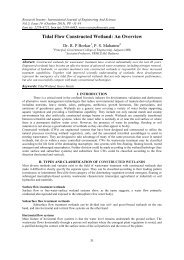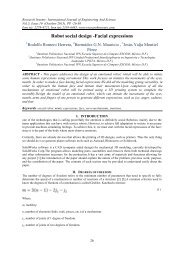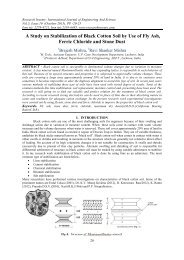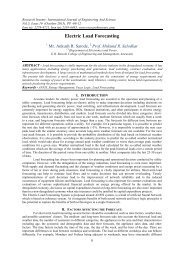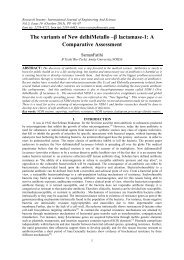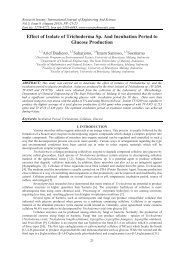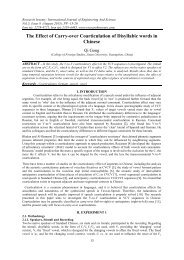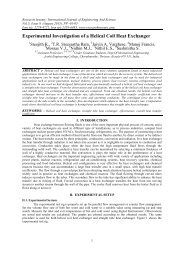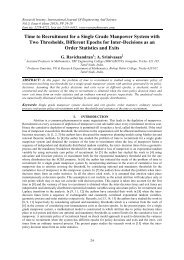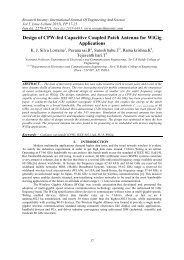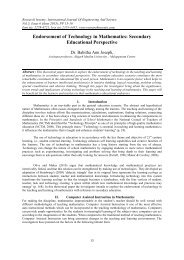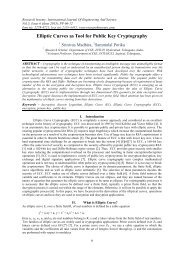An empirical review of Motivation as a Constituent to Employees’ Retention
You also want an ePaper? Increase the reach of your titles
YUMPU automatically turns print PDFs into web optimized ePapers that Google loves.
Research Inventy: International Journal Of Engineering <strong>An</strong>d Science<br />
Vol.5, Issue 2 (February 2015), PP 06-15<br />
Issn (e): 2278-4721, Issn (p):2319-6483, www.researchinventy.com<br />
<strong>An</strong> <strong>empirical</strong> <strong>review</strong> <strong>of</strong> <strong>Motivation</strong> <strong>as</strong> a <strong>Constituent</strong> <strong>to</strong> <strong>Employees’</strong><br />
<strong>Retention</strong><br />
Adanma Cecilia Eberendu , Rita Kenneth-Okere<br />
Madonna University, Elele, Rivers State, Nigeria<br />
ABSTRACT : This study investigated the link between motivation and retention and the effect <strong>of</strong> motivation<br />
on retention at different organisational levels. The research linked motivation and high job satisfaction <strong>to</strong><br />
explore strategies that help in employees’ retention and why public sec<strong>to</strong>r employees leave with particular<br />
reference <strong>to</strong> Federal Medical Centre (FMC) Owerri. This w<strong>as</strong> achieved by collecting primary data from Federal<br />
Medical Centre (FMC) on non-clinical staff/employees (managers and non-managers and secondary data from<br />
published materials and the hospital’s human resources (HR) data. The findings were tested using employee<br />
motivational attributes <strong>to</strong> prove that motivation plays a crucial role in enhancing employee retention. <strong>Motivation</strong><br />
w<strong>as</strong> found <strong>to</strong> be a core fac<strong>to</strong>r that determines the level <strong>of</strong> employee retention among managers and nonmanagers<br />
within the c<strong>as</strong>e study organisation. Specifically, it w<strong>as</strong> found out that employees tend <strong>to</strong> be motivated<br />
if they are subjected <strong>to</strong> performance-b<strong>as</strong>ed compensation, recognition for good work, and encouraged <strong>to</strong> pursue<br />
individually fulfilling t<strong>as</strong>ks.<br />
KEYWORDS: <strong>Motivation</strong>, Job Satisfaction, <strong>Retention</strong>, Organization, Employees<br />
I. INTRODUCTION<br />
Organisations go a long way <strong>to</strong> recruit workers, who after a short period move on <strong>to</strong> another<br />
organisation. Employers and managers should have efficient motivation and retention strategies in order <strong>to</strong><br />
retain these great people. This work is an extension <strong>of</strong> previous research on related <strong>to</strong>pic by human resource<br />
experts and other renowned scholars. According <strong>to</strong> Bloom & Berina<strong>to</strong> (2014), Ctrip, a company in US w<strong>as</strong> able<br />
<strong>to</strong> save about $1,900 per employee <strong>as</strong> a result <strong>of</strong> working from home-flexible working arrangement. The<br />
academic focus and research rationale in addition <strong>to</strong> the objectives stated below is <strong>to</strong> reduce or completely<br />
eradicate the loss <strong>of</strong> intellectual capital in public sec<strong>to</strong>r organisations in particular and private sec<strong>to</strong>r<br />
organisations in general. It is <strong>to</strong> reduce constant staff turnover, incre<strong>as</strong>e productivity and pr<strong>of</strong>itability in<br />
organisations, and <strong>to</strong> improve on already existing motivation strategy <strong>to</strong> retain employee. One <strong>of</strong> the questions<br />
<strong>to</strong> be answered here is whether motivation h<strong>as</strong> anything <strong>to</strong> do with retention and at what level <strong>of</strong> the<br />
organisation does this have more effect? <strong>An</strong>other question is <strong>to</strong> check whether motivation h<strong>as</strong> any link with high<br />
job satisfaction, incre<strong>as</strong>ed performance, and retention. The research will also look at why people leave and what<br />
are those motivation strategies that help in workers retention. Furthermore, comparison <strong>of</strong> two organisations;<br />
one <strong>of</strong> small scale and another <strong>of</strong> a larger scale may be carried out <strong>to</strong> know the strategies in place for retention in<br />
both organisations.<br />
However, it is important <strong>to</strong> note that in difficult economic times such <strong>as</strong> now retention may be higher<br />
because it is difficult or hard <strong>to</strong> find other work. Although, Kumar & Arora (2012), argue that nowadays<br />
organisations are afflicted with talent shortage issues, and administra<strong>to</strong>rs and managers have realised the<br />
competitive advantage in having competent staff. Furthermore, efficient and productive workforce make<br />
organisations <strong>to</strong> survive, and flourishing is consequential <strong>to</strong> rapidly incre<strong>as</strong>ing focus on retaining key talent or<br />
valued employees. This group represent the <strong>to</strong>tal <strong>of</strong> the inherent abilities, acquired knowledge, capabilities and<br />
skills. Again, diversity in workforce, sex, age, qualifications, competence, experience, quality, and perception<br />
have incre<strong>as</strong>ed retention issues. The above claim on efficient and productive workforce can further be buttressed<br />
by the fact that Federal Medical Centre is interested in attracting and retaining high quality staff in order <strong>to</strong><br />
provide patients with the best clinical care possible. Considering the merits <strong>of</strong> long service and the role <strong>of</strong><br />
experience in business it is vital for management <strong>to</strong> preserve vital employees for companies’ success and<br />
survival. It is absolutely necessary for employers <strong>to</strong> maintain adequate number <strong>of</strong> employees <strong>as</strong> people leave due<br />
<strong>to</strong> various re<strong>as</strong>ons in these competitive industries (Adam et al, 2007). Similarly, companies’ keeping skilled<br />
employees via motivation is crucial because <strong>of</strong> the time and money it takes <strong>to</strong> replace them. While a small<br />
number <strong>of</strong> employees leaving an organisation is naturally acceptable, Kumar & Arora (2012) and other human<br />
resources management (HRM) experts opined that high turnover is <strong>of</strong> serious concern. Incre<strong>as</strong>ed attrition level<br />
adversely affects the overall performance <strong>of</strong> any organisation, and needs <strong>to</strong> be moni<strong>to</strong>red and managed<br />
carefully. From a retention perspective, employees that are strategic <strong>to</strong> the mission and difficult <strong>to</strong> replace<br />
should be the focus <strong>of</strong> most businesses, much effort should be made <strong>to</strong> keep them (Breslin, 2013).<br />
6
<strong>An</strong> <strong>empirical</strong> <strong>review</strong> <strong>of</strong> <strong>Motivation</strong>...<br />
Considering self determination theory (SDT), “Work climate that promote satisfaction <strong>of</strong> the three<br />
b<strong>as</strong>ic psychological needs <strong>of</strong> au<strong>to</strong>nomy, competence and relatedness enhances employees’ intrinsic motivation<br />
and promote full internalisation <strong>of</strong> extrinsic motivation that yield important work outcomes in return” (Gagne &<br />
Deci, 2005). Hence, high retention level depends on having a great workforce. To become an employer <strong>of</strong><br />
choice with high rate <strong>of</strong> employee retention, organisations must focus on strategies that enhances motivation,<br />
recognition and rewards (Branch, 2011). <strong>An</strong>alogously, the problem <strong>of</strong> employee retention can be addressed<br />
through a variety <strong>of</strong> proactive retention strategies, workplace policies and practices which would not only help<br />
<strong>of</strong>fset negative impact <strong>of</strong> employee retention but also work proactively <strong>to</strong> incre<strong>as</strong>e it (Kumar & Arora, 2012).<br />
According <strong>to</strong> Drost (2010), employee's career future, job performance, organizational support and job<br />
satisfaction are all part <strong>of</strong> their decision <strong>to</strong> remain with an organization in <strong>to</strong>day's complex and competitive job<br />
market. In this research, however, organisational support (motivation) will be looked at <strong>as</strong> a key element <strong>to</strong> their<br />
decision <strong>to</strong> remain (retention). Public sec<strong>to</strong>r organisations are distinguished from other organisations and are<br />
made attractive <strong>to</strong> employees by emph<strong>as</strong>ising on motivational fac<strong>to</strong>rs such <strong>as</strong> available career opportunities,<br />
skills and training needs for a challenging future position. It is important <strong>to</strong> stress that this is an extension <strong>of</strong><br />
earlier studies, (Drost, 2010; M<strong>as</strong>ibigiri & Nienaber, 2011), which established that managers relationships <strong>to</strong><br />
subordinates are key <strong>to</strong> their motivation and retention. B<strong>as</strong>ed on the above claims, the study will further carry<br />
out a critical literature <strong>review</strong> in following section <strong>to</strong> explore these claims further. This study therefore<br />
investigated the link between motivation and retention, and the effect <strong>of</strong> motivation on retention at different<br />
levels <strong>of</strong> the organisation in which high job satisfaction and motivation strategies were explored.<br />
II.<br />
RELATED LITERATURE<br />
2.1 <strong>Motivation</strong><br />
Most organisations are not immune <strong>to</strong> national economic pressures affecting the geographical regions<br />
the organisation serves. Larger workforce presents challenges for recognising and rewarding the <strong>as</strong>pirations and<br />
contributions <strong>of</strong> the employees <strong>as</strong> it may equate <strong>to</strong> more expansive capabilities for serving clients (Branch,<br />
2011). According <strong>to</strong> Cristescu et al (2013), employees could be intrinsically or extrinsically motivated; the<br />
intrinsic fac<strong>to</strong>rs <strong>of</strong> motivation are relations between the expectations, perceptions and feelings <strong>of</strong> an individual<br />
on the one hand, and the actual content <strong>of</strong> the individual’s work and behaviour on the other hand. Extrinsic<br />
motivation is also b<strong>as</strong>ed on individual-organisation relationship and is meant <strong>to</strong> meet employee’s expectations<br />
with regard <strong>to</strong> the organisational reactions in relation <strong>to</strong> employees’ efforts, behaviour and results. Vroom<br />
(1964) defines motivation <strong>as</strong> the ‘force’ impelling a person <strong>to</strong> perform a particular action, determined by the<br />
interaction <strong>of</strong> (i) person’s expectancy that the act will be followed by a particular outcome and (ii) the valence <strong>of</strong><br />
that outcome, which in turn is a function <strong>of</strong> the valences <strong>of</strong> all other outcomes. The main idea behind M<strong>as</strong>low’s<br />
needs hierarchy concerns employers responsibility <strong>to</strong> provide environment <strong>of</strong> workplace that encourages and<br />
enables employees <strong>to</strong> fulfil their own unique potential or self-actualisation (M<strong>as</strong>low, 1954). This hierarchy <strong>of</strong><br />
needs model/theory developed in the 1940-50s remains valid till <strong>to</strong>day for the understanding <strong>of</strong> human<br />
motivation, management training and personal development (M<strong>as</strong>low, 1943). With this theory managers<br />
understand how <strong>to</strong> motivate employees and channel motivation <strong>to</strong>wards work for retention (Manion, 2005).<br />
Knowing the purpose <strong>of</strong> the job and doing everything with that purpose in mind incre<strong>as</strong>es motivation. Focusing<br />
exclusively on extrinsic rewards costs more and do not incre<strong>as</strong>e commitment (Ayers, 2008). However, four<br />
intrinsic rewards that incre<strong>as</strong>e motivation are senses <strong>of</strong> meaning, choice, competence and progress. This is in<br />
line with Meyer et al (2003) argue that building effective commitment involve more than paying well, and that<br />
retention b<strong>as</strong>ed on compensation b<strong>as</strong>e commitment (motivation) is <strong>of</strong> course sensitive <strong>to</strong> changes in<br />
compensation within the organisation. Organisations that indulge in this form <strong>of</strong> retention strategy are <strong>of</strong>ten<br />
vulnerable <strong>to</strong> the possibility that competi<strong>to</strong>rs may use better wage <strong>of</strong>fers <strong>to</strong> lure away employees. Hence, Smith<br />
(2001), states that money gets employees <strong>to</strong> the door, but does not keep them there.<br />
According <strong>to</strong> Jeswani and Souren (2008), employees’ engagement is necessary in their retention <strong>as</strong> disengaged<br />
employee disturbs the system and can multiply dissatisfaction level resulting <strong>to</strong> decre<strong>as</strong>ed motivation,<br />
diminished performance and high employee turnover. Again, Kumar & Arora (2012) argue that the determinants<br />
affecting an employee’s decision <strong>to</strong> stay or leave an organisation depends primarily on organisational culture,<br />
probably because <strong>of</strong> the fact that job satisfaction and performance level are influenced by working conditions.<br />
Therefore, performance level and job satisfaction depend on working conditions. This is also in line with<br />
Kuva<strong>as</strong> (2008) conclusion in his research on Employee-Organisation Relationship (EOR). Developmental<br />
perception <strong>of</strong> HR practices by employees may not translate in<strong>to</strong> higher work performance. Again, poorly<br />
managed employee-organisation relationship should not be compensated with investment in HR practices<br />
because work performance may actually be reduced by developmental practices due <strong>to</strong> lack <strong>of</strong> high quality<br />
employee-organisation relationship (Kuva<strong>as</strong> B., 2008).<br />
7
<strong>An</strong> <strong>empirical</strong> <strong>review</strong> <strong>of</strong> <strong>Motivation</strong>...<br />
According <strong>to</strong> Siegfried Jr (2008) employees work with integrity and p<strong>as</strong>sion when employers <strong>of</strong> labour<br />
identify, engage and retain people who enjoy what they do, this is the bot<strong>to</strong>m line. Siegfried Jr (2008) added<br />
that staff turnover can better be controlled at the point <strong>of</strong> recruitment. Also, recruiters needs <strong>to</strong> identify among<br />
other preferences whether an applicant is a road warrior (just after money) or not, and <strong>to</strong> understand the kind <strong>of</strong><br />
career path employees are looking for. Getting employees <strong>to</strong> be committed is very important <strong>to</strong> any business<br />
because, O’Malley (2000) stated that commitment is critical <strong>to</strong> organisational performance but not a panacea.<br />
There are other ingredients O’Malley explains that need <strong>to</strong> be added <strong>to</strong> mix, <strong>to</strong> achieve important organisational<br />
ends and when blended in the right complements, motivation becomes the result.<br />
According <strong>to</strong> Barber (2009), motivation can be negative or positive, that inspiration taps in<strong>to</strong> our inner<br />
good and better day is always seen coming and it is always positive. Intrinsic motivation prevails over the<br />
extrinsic one when referring <strong>to</strong> the activity in a public institution, which deals with educational services, while<br />
the activity in a private company, which deals with car construction, is dominated by the extrinsic motivation<br />
(Marius & Radu, 2009). Scott (2012) in conjunction with other HRM literature w<strong>as</strong> able <strong>to</strong> point out that money<br />
alone may not be a huge motiva<strong>to</strong>r for <strong>to</strong>p performances in an organisation, especially the NPOs. Organizations<br />
that have taken employee-centric investment approach <strong>to</strong> rewarding employees for their contributions<br />
consistently achieve best-place-<strong>to</strong>-work status. Statu<strong>to</strong>ry organizations that have invested in a partnership<br />
between human resources and line management <strong>to</strong> implement an effective employee reward strategy-one that<br />
makes a meaningful distinction around employee performance-have tended <strong>to</strong> fare better than their counterparts<br />
in Office <strong>of</strong> Personal Management (OPM) biannual survey (Rowson, 2009). This point can be stressed further<br />
by the talk with Maria Paviour on employee engagement: ‘we need <strong>to</strong> look at the way we reward and pay<br />
people, because we know through research that bigger bonuses do not motivate. In fact, bonuses crush<br />
creativity: the bigger the bonus, the worse the performance (IDS HR in Practice, 2013). Scott (2012), suggested<br />
that Key employees should indicate the benefits they value most, and rewards programme should be cus<strong>to</strong>mised<br />
<strong>to</strong> satisfy them. This point seems <strong>to</strong> tally with that <strong>of</strong> the critics <strong>of</strong> expectancy theory in some ways; particularly<br />
that <strong>of</strong> Edward Lawler’s new proposal for expectancy theory which is not against that <strong>of</strong> Vroom’s theory. For<br />
instance, one <strong>of</strong> the four claims Lawler’s model is b<strong>as</strong>ed on is that individual’s belief <strong>of</strong> their desired outcome<br />
being achievable through their action(s), (Lawler & Suttle, 1973). The FMC may be facing specific human<br />
resources concerns; the variety <strong>of</strong> employee motivation, recognition, rewards and retention steps taken may be<br />
altered or adapted <strong>to</strong> address varying circumstances (Branch, 2011). Again, Branch argues that compensation is<br />
a motivating fac<strong>to</strong>r for employees; however, addressing it in difficult economic times is not always very e<strong>as</strong>y.<br />
According <strong>to</strong> People Management (2008), most people go <strong>to</strong> work for money, and that there are different<br />
motiva<strong>to</strong>rs for workers with similar skills. The earlier statement w<strong>as</strong> contradicted by Psychologists affirming<br />
that money is generally a powerful de-motiva<strong>to</strong>r and a weak long-term motiva<strong>to</strong>r (People Management, 2008).<br />
Rawson (2009) further argues that there is the need <strong>to</strong> develop programmes that help federal workers achieve<br />
work-life balance and consequently reduce stress in the workplace, which w<strong>as</strong> supported by the 2008 Human<br />
Capital Survey conducted by the Office <strong>of</strong> Personal Management (OPM). Public sec<strong>to</strong>r organisations have<br />
distinguished themselves and are recognised for ‘best practice’ and <strong>as</strong> best places <strong>to</strong> work by the workforce<br />
which appears <strong>to</strong> be one <strong>of</strong> the re<strong>as</strong>ons why those that stay or l<strong>as</strong>t on a job do.<br />
2.2 <strong>Motivation</strong> Approach in the Federal Medical Centre (FMC) Owerri<br />
Motivating FMC employees requires lots <strong>of</strong> resources including time, and an attempt <strong>to</strong> avoid such<br />
investment could be costly or dev<strong>as</strong>tating <strong>to</strong> an organisation. <strong>An</strong> incre<strong>as</strong>ed turnover is one <strong>of</strong> the consequences<br />
<strong>of</strong> not investing in employee motivation which invariably incre<strong>as</strong>es labour cost. To avoid/ reduce turnover cost,<br />
Dermody et al (2004) emph<strong>as</strong>ise that managers should understand and moni<strong>to</strong>r employees’ motivation. To<br />
inspire sense <strong>of</strong> duties <strong>of</strong> subordinates in the FMC, managers endeavour <strong>to</strong> discover their internal feelings in the<br />
interest <strong>of</strong> the care sec<strong>to</strong>r. Again, job satisfaction with regard <strong>to</strong> employees’ motivation is <strong>of</strong> great importance<br />
since satisfied employees feel happy and are able <strong>to</strong> deliver when adequately rewarded. Job satisfaction<br />
therefore plays a great role with regards <strong>to</strong> non-attendance, work performance, labour turnover and tendency <strong>to</strong><br />
quit, which Tutuncu and Kazak (2006) say leads <strong>to</strong> cost efficiency. Wage rates below minimum wage or<br />
prevailing market rate will lead <strong>to</strong> employee dissatisfaction, unacceptable behaviour and lack <strong>of</strong><br />
pr<strong>of</strong>essionalism, or even worse still, incre<strong>as</strong>e staff turnover (Akerl<strong>of</strong> Yellen, 1986, cited in Taylor and Taylor,<br />
2011). While higher pay results in rise in productivity, employee responsibility and loyalty and workplace<br />
cohesiveness (Westly & Schmidt, 2006, cited in Taylor & Taylor, 2011). Most researchers, (Miller (1980), and<br />
Ting (1997)), are <strong>of</strong> the opinion that there exist a direct relationship between job satisfaction and pay, thus they<br />
are strongly correlated or linked.<br />
8
<strong>An</strong> <strong>empirical</strong> <strong>review</strong> <strong>of</strong> <strong>Motivation</strong>...<br />
2.3 <strong>Retention</strong><br />
According <strong>to</strong> Cran (2012), the biggest challenge facing an organisation is keeping or retaining <strong>to</strong>p<br />
talents (valued employees), considering <strong>to</strong>day’s workers attitudes and changing times. Retaining talent refers <strong>to</strong><br />
employers' efforts <strong>to</strong> create an environment that engages employees for the long term and ensures that they keep<br />
desirable workers in order <strong>to</strong> meet business objectives (M<strong>as</strong>ibigiri & Nienaber ,2011; Frank, Finnegan & Taylor,<br />
2004). However, if employees are not satisfied with these efforts they can leave. Therefore, retention results<br />
from mutual satisfaction between employees and employers and occurs voluntarily (Kon<strong>to</strong>ghiorghes &<br />
Frangrou, 2009). It is because <strong>of</strong> the significant importance <strong>of</strong> talent retention <strong>as</strong> a strategic <strong>to</strong>ol <strong>to</strong> ensure workperformance<br />
superiority that it continues <strong>to</strong> <strong>to</strong>p the list <strong>of</strong> priorities <strong>of</strong> CEOs (Kumar & Arora, 2012). As<br />
stressed by Siegfried Jr (2008), lack <strong>of</strong> proper communication <strong>to</strong> eliminate uncertainties could also make<br />
employees leave: “If there is bad news be honest and let employees know what the plan is <strong>as</strong> soon <strong>as</strong> possible;"<br />
and that “The longer people sit in an uncertain situation, the more likely they are <strong>to</strong> start taking those phone<br />
calls and start looking around". Establishing proper communication between managers and subordinates is<br />
paramount <strong>to</strong> retention. Benefits and pay may be additional incentives or ways but not main re<strong>as</strong>ons for<br />
employees’ retention. For instance, communication, employee absenteeism, and productivity were found <strong>to</strong> go<br />
concurrently and poor communication is one <strong>of</strong> the main re<strong>as</strong>ons for employee turnover (Drost, 2010).<br />
Leadership is another key fac<strong>to</strong>r <strong>to</strong> employee retention (M<strong>as</strong>ibigiri & Nienaber, 2011). They argue that<br />
leadership play an important role in the needs <strong>of</strong> employees, manager-leader must communicate with employees<br />
regarding their needs; likes and dislikes. As soon <strong>as</strong> employees think that their values are incompatible with<br />
those <strong>of</strong> their organisations, they are prepared <strong>to</strong> leave. Furthermore, ongoing leadership skill development from<br />
the Top bot<strong>to</strong>m is very crucial, since people do not leave their jobs but leave their leaders (Cran, 2012).<br />
Scott (2012) states that employers must focus retention efforts on their highest performers in order <strong>to</strong> strive in<br />
<strong>to</strong>day’s economy. Lochhead and Stephens (2004) emph<strong>as</strong>is that skills, experience and corporate memory are<br />
lost when business losses employees: Consequently, productivity, pr<strong>of</strong>itability and quality <strong>of</strong> product and<br />
services are affected depending on the nature and magnitude <strong>of</strong> the loss, which is a critical management issue. It<br />
is important <strong>to</strong> point out that most <strong>of</strong> the retention practices (Recognition and Rewards; Compensation and<br />
Benefits; Training, Pr<strong>of</strong>essional Development, Career Planning; Recruitment and Orientation; Healthy<br />
Workplace or Wellness Programmes; Work-life Balance; Job Design and Work Teams; Employee participation<br />
and Communication) listed in the HR literatures including (Lochhead and Stephens, 2004) are fac<strong>to</strong>rs that<br />
inspire and build motivation (motivation fac<strong>to</strong>rs). Ashby and Pell (2001 cited in Lochhead and Stephens, 2004)<br />
argue that inflexible companies characterised by dominant and au<strong>to</strong>cratic organisational culture are likely <strong>to</strong><br />
have dissatisfied employees not minding how fant<strong>as</strong>tic the incentives <strong>to</strong> stay might be. Again, in evaluating<br />
disutility from work effort arising from different external constraint (care for sick family member or children)<br />
that draws on someone’s energy and work concentration, Delfgaauw and Dur (2008) reported a remarkable<br />
difference in the number <strong>of</strong> workers that move from private sec<strong>to</strong>r jobs <strong>to</strong> public sec<strong>to</strong>r job where flexible work<br />
arrangement is highly practiced than those that move from public <strong>to</strong> private sec<strong>to</strong>r.<br />
According <strong>to</strong> Siegfried (2008), even though Siegfried Group look for people that identifies with the<br />
organisation’s culture and are experienced, the Group still promise them a distinctive culture that balances<br />
career and life; compelling business strategy; work that is both challenging and personally gratifying; attractive<br />
compensation and other benefits. Parry (2008) argues that organisations that invest in their staff are best placed<br />
<strong>to</strong> save money, improve staff motivation and incre<strong>as</strong>e employee retention. According <strong>to</strong> the report on Nurturing<br />
Talents, successful organisations are typified by using formal training policies <strong>to</strong> nurture talents, and that over<br />
three quarters <strong>of</strong> employers see skills development <strong>as</strong> more beneficial <strong>to</strong> their organisation than external<br />
recruitment. She added that organisations do not only save money by growing their own but will also get<br />
required talent. This is why organisations that have identified key employees never let them go.<br />
2.4 Employee <strong>Retention</strong> <strong>Motivation</strong><br />
Paying above the labour market, according <strong>to</strong> Scott (2012) helps retain good people, which ‘retention<br />
<strong>of</strong> key talent and the role <strong>of</strong> rewards’ confirm. However, IDS (institute <strong>of</strong> development studies) HR in Practice<br />
(2013), suggests that organisations need <strong>to</strong> be mindful <strong>of</strong> how they reward and pay employees. <strong>An</strong>d that<br />
research h<strong>as</strong> shown that bigger bonuses do not motivate, rather bonuses crush creativity: the bigger the bonus,<br />
the worst the performance. Although the c<strong>as</strong>e study <strong>of</strong> Home Group in the same IDS HR in Practice (2013),<br />
argues that talent could be lost when mediocre are financially rewarded, hence the introduction <strong>of</strong> performance<br />
b<strong>as</strong>ed increment <strong>as</strong> against the old f<strong>as</strong>hioned tenure b<strong>as</strong>ed system <strong>of</strong> pay increment. ‘If organisation wants <strong>to</strong><br />
have a more productive workforce, you need <strong>to</strong> have people who are emotionally engaged’ (IDS HR in Practice,<br />
2013). This implies that more productive workforce results in high productivity and incre<strong>as</strong>ed pr<strong>of</strong>itability.<br />
Bloom & Berina<strong>to</strong> (2014) viewed this idea from the flexible work angle when they say “To raise productivity,<br />
let more employees work from home”. In comparison with the staff that came in<strong>to</strong> the <strong>of</strong>fice, the study revealed<br />
9
<strong>An</strong> <strong>empirical</strong> <strong>review</strong> <strong>of</strong> <strong>Motivation</strong>...<br />
that at-home workers were not only happier and less likely <strong>to</strong> leave but also more productive. Again, one <strong>of</strong> the<br />
re<strong>as</strong>ons for the Ctrip experiment is <strong>to</strong> prove that flexible working does not hinder performance but motivates.<br />
III. RESEARCH METHODOLOGY<br />
Both primary and secondary data were utilised in this research. Interviews, questionnaires and c<strong>as</strong>e study were<br />
the techniques used for the primary data collection, and this broadens the depth <strong>of</strong> the data given that just one<br />
organisation is under study (Cochran, 2007; Cohen et al, 2007). The determined samples are made up <strong>of</strong> five<br />
managers and twenty-five (25) non-managers, making a <strong>to</strong>tal <strong>of</strong> thirty (30) respondents. This sample size w<strong>as</strong><br />
considered ideal and a good representation <strong>of</strong> the entire population. Again, the choice <strong>of</strong> this sample size w<strong>as</strong> in<br />
view <strong>of</strong> the resources (time and money) available, more so that the research w<strong>as</strong> self sponsored and the<br />
researchers’ choice <strong>of</strong> precision level (Cochran, 2007).<br />
IV. FINDINGS AND ANALYSIS<br />
Data w<strong>as</strong> analysed using inferential statistics. Specifically, the regression analysis w<strong>as</strong> carried <strong>to</strong> establish the<br />
link or relationship between motivation and retention. Also a simple correlation coefficient (Pearson’s productmoment)<br />
w<strong>as</strong> calculated <strong>to</strong> me<strong>as</strong>ure or <strong>as</strong>sess the nature and strength <strong>of</strong> the relationship between motivation and<br />
retention. A regression analysis w<strong>as</strong> carried out on the construct from the reliability test for the purpose <strong>of</strong><br />
testing the validity and reliability <strong>of</strong> the study’s two (null and alternative) hypotheses: H o : <strong>Motivation</strong> is a key<br />
element <strong>to</strong> employee retention, and; H 1 : <strong>Motivation</strong> is NOT a key element <strong>to</strong> employee retention. The test<br />
statistics w<strong>as</strong> computed using the SPSS Package’s Reliability, Regression and Correlation function on the<br />
combined data or responses from both non-managers and managers. The values <strong>of</strong> the regression and correlation<br />
coefficients and the ANOVA table were imported directly from SPSS.<br />
a. Correlation <strong>An</strong>alysis<br />
To test the strength <strong>of</strong> the relationship between the independent variable (motivation) and the dependent<br />
variable (employee retention), the Pearson’s product-moment correlation coefficient w<strong>as</strong> used for each <strong>of</strong> 33<br />
questions forming the six categories. To achieve this, the responses for all the 30 respondents (managers and<br />
non-managers) were grouped in<strong>to</strong> six core categories. The SPSS output shown on Table 1 below indicates that<br />
the Cronbach’s Alpha score for the questions forming the first category w<strong>as</strong> .586, second category w<strong>as</strong> .797,<br />
third category w<strong>as</strong> .223, fourth category w<strong>as</strong> .629, fifth category w<strong>as</strong> .704, and sixth category w<strong>as</strong> .879. The<br />
correlation coefficients for the first, second, fourth, fifth, and sixth categories were calculated. However, the<br />
correlations coefficient for the third category <strong>of</strong> question w<strong>as</strong> not computed since it had a low Cronbach’s Alpha<br />
score <strong>of</strong> .223 which indicates a low level <strong>of</strong> consistency between the items (questions) being tested. This means<br />
that, comparatively, support services do not play a major role in influencing the employee retention within the<br />
c<strong>as</strong>e study organisation.<br />
Table 1: Cronbach’s alpha for the constructs<br />
Section No Construct Dimensions Cronbach’s Alpha<br />
1 Clear roles for team 3 0.892<br />
2 Personal development 3 0.797<br />
3 Support and opportunities<br />
4 Engagement(<strong>Retention</strong>) 4 0.629<br />
5 Staff satisfaction 4 0.704<br />
6 Compensation 7 0.879<br />
As Table 2 below shows, the correlation analysis w<strong>as</strong> b<strong>as</strong>ed on the individual scores (responses) for each <strong>of</strong> the<br />
five core <strong>as</strong>pects <strong>of</strong> employee motivation, that is, team roles, personal development, employee engagement,<br />
employee satisfaction, and employee compensation. To allow for objective testing, the correlation analysis w<strong>as</strong><br />
b<strong>as</strong>ed on two-tailed tests, meaning that the correlation between the independent and dependent variables w<strong>as</strong><br />
tested for both directions, that is, positive and negative directions from the significant level or either 0.01 and<br />
0.05.<br />
10
<strong>An</strong> <strong>empirical</strong> <strong>review</strong> <strong>of</strong> <strong>Motivation</strong>...<br />
Table 2: Correlations <strong>An</strong>alysis<br />
Correlations<br />
Team Development Engagement Satisfaction Compensation<br />
roles<br />
Team roles Pearson<br />
1 -.067 -.052 .095 .085<br />
Correlation<br />
Sig. (2-tailed) .724 .785 .619 .656<br />
N 30 30 30 30 30<br />
Development Pearson -.067 1 .638 ** .273 .497<br />
Correlation<br />
Sig. (2-tailed) .724 .000 .144 .005<br />
N 30 30 30 30 30<br />
Engagement Pearson -.052 .638 ** 1 .273 .532 **<br />
Correlation<br />
Sig. (2-tailed) .785 .000 .144 .002<br />
N 30 30 30 30 30<br />
Satisfaction Pearson<br />
.095 .273 .273 1 .074<br />
Correlation<br />
Sig. (2-tailed) .619 .144 .144 .697<br />
N 30 30 30 30 30<br />
Compensation Pearson<br />
.085 .497 ** .532 ** .074 1 **<br />
Correlation<br />
Sig. (2-tailed) .656 .005 .002 .697<br />
N 30 30 30 30 30<br />
**. Correlation is significant at the 0.01 level (2-tailed).<br />
*. Correlation is significant at the 0.05 level (2-tailed).<br />
As shown in Table 2 above there is a positive correlation between team roles on one hand, and<br />
employee satisfaction and employee compensation on the other, with regards <strong>to</strong> employee retention in the c<strong>as</strong>e<br />
study organisation <strong>as</strong> denoted by positive correlations <strong>of</strong> .095 and .085, respectively. There is also a negative<br />
correlation between team roles, personal development and engagement <strong>as</strong> denoted by negative correlations <strong>of</strong> -<br />
.067 and -.052 respectively. Although, these relationships may be weak <strong>as</strong> indicated by their low values, but<br />
positive in the sense that both variables incre<strong>as</strong>e and decre<strong>as</strong>e simultaneously while negative correlation imply<br />
that an incre<strong>as</strong>e in one variable is <strong>as</strong>sociated with a decre<strong>as</strong>e <strong>of</strong> the other variable. It is equally important <strong>to</strong> point<br />
out that the highest value <strong>of</strong> a correlation coefficient is ±1. A 2-tailed specifies how statistically significant a<br />
correlation between variables is. That is, incre<strong>as</strong>e or decre<strong>as</strong>e in one variable does or does not significantly<br />
relate <strong>to</strong> incre<strong>as</strong>e or decre<strong>as</strong>e <strong>of</strong> the other variable. When significant (2-tail) values are less than or equal <strong>to</strong> 0.05,<br />
the conclusion is always that there is a statistically significant correlation between the variables (Cochran, 2007;<br />
Saldana, 2012). Therefore, the high significant levels in almost all the correlation boxes can be interpreted <strong>to</strong><br />
mean that a change in one variable may not necessarily indicate a change in the other <strong>as</strong> they relate <strong>to</strong> employee<br />
retention in the c<strong>as</strong>e study organisation. This means that each <strong>of</strong> the five motivation variables h<strong>as</strong> a somehow<br />
independent influence on employee retention. However, the purpose <strong>of</strong> this study is <strong>to</strong> me<strong>as</strong>ure how these<br />
variables collectively influence employee retention and not how individual variable influences employee<br />
retention, this independent influence w<strong>as</strong> not me<strong>as</strong>ured.<br />
The above claim on engagement and retention can further be supported by the works <strong>of</strong> Jeswani and<br />
Souren (2008). As pointed out in chapter two above, engagement is necessary for employees’ retention, and so,<br />
the researcher can comfortably argue that the motivation fac<strong>to</strong>rs considered in this research that are correlated<br />
with staff engagement are invariably correlated with retention. Again, a strong link between engagement and<br />
retention w<strong>as</strong> also pointed out by Siegfried Jr (2008) in chapter two, <strong>as</strong> the bot<strong>to</strong>m line for people that enjoy<br />
what they do. <strong>An</strong> extension <strong>of</strong> these links shows the relationship between retention and the motivational fac<strong>to</strong>rs<br />
considered in the c<strong>as</strong>e study organisation <strong>of</strong> this work. Therefore, the low significant level between personal<br />
development and engagement (.000), personal development and compensation (.005), and engagement and<br />
compensation (.002) can be interpreted <strong>to</strong> mean that a change in either <strong>of</strong> the variables in each <strong>of</strong> these three<br />
pairs may occ<strong>as</strong>ion a change <strong>of</strong> the other variable in the same pair <strong>as</strong> they relate <strong>to</strong> employee retention in the<br />
c<strong>as</strong>e study organisation. L<strong>as</strong>tly, the correlation between these three pairs <strong>of</strong> predic<strong>to</strong>r variables is more<br />
11
<strong>An</strong> <strong>empirical</strong> <strong>review</strong> <strong>of</strong> <strong>Motivation</strong>...<br />
pronounced given the relatively low significant level (2-tailed) <strong>of</strong> 0.01 compared <strong>to</strong> other pairs whose<br />
significant level (2-tailed) is at 0.05.<br />
Similarly, the matrix <strong>of</strong> correlation between fac<strong>to</strong>rs or the six constructs is showing that compensation<br />
and personal development are most correlated with others. The fact that compensation’ correlation is not very<br />
strong is in line with Maria Paviour’s talk on employee engagement: We need <strong>to</strong> look at the way we reward and<br />
pay people, because we know through research that bigger bonuses do not motivate. In fact, bonuses crush<br />
creativity: the bigger the bonus, the worse the performance (IDS HR in Practice, 2013). For personal<br />
development whose correlation coefficient appears high and stronger with engagement is in line with Steers &<br />
Porter (1983), argument with regard <strong>to</strong> employees developing <strong>to</strong> their full potential; Failure <strong>to</strong> provide proper<br />
climate that supports employees’ fullest potential development would incre<strong>as</strong>e employees’ frustration and<br />
amounts <strong>to</strong> poorer performance, lower job satisfaction and incre<strong>as</strong>ed withdrawal,(Steers & Porter, 1983a).<br />
4.2 Regression <strong>An</strong>alysis<br />
SPSS package w<strong>as</strong> used <strong>to</strong> compute the regression analysis which describes statistical relationship<br />
between the independent and dependent variables. This analysis used the ANOVA (analysis <strong>of</strong> variance)<br />
framework that captures the statistical relationship between the outcome variable and the predic<strong>to</strong>r variables.<br />
Again, the analysis w<strong>as</strong> carried out along the five categories <strong>of</strong> questions highlighted earlier.<br />
Table 3a: ANOVA<br />
ANOVA a<br />
Model Sum <strong>of</strong> Squares Degrees <strong>of</strong> freedom Mean Square F<br />
1 Regression 14.096 4 3.524 5.911<br />
Residual 14.904 25 .596<br />
Total 29.000 29<br />
As Table 3a above shows, the F-value for the statistical relationship between the dependent variable<br />
(engagement) and predic<strong>to</strong>r variables (constant, compensation, satisfaction, team roles, and personal<br />
development) is 5.911. The F-value w<strong>as</strong> used <strong>to</strong> capture the appropriateness <strong>of</strong> the regression model in testing<br />
the statistical relationship between the dependent and predic<strong>to</strong>r variables. Like the preceding analyses, the F-<br />
value w<strong>as</strong> computed using the SPSS package 21. In this regard, an F-value <strong>of</strong> 5.911, this indicates a relatively<br />
low chance <strong>of</strong> some <strong>of</strong> the regression parameters being zeros or that the statistical relationship between the<br />
predic<strong>to</strong>r variables and the outcome variable is not purely random. Further, a very small difference between the<br />
regression value <strong>of</strong> 14.096 and residual value <strong>of</strong> 14.904 indicates that there is a very small difference between<br />
what w<strong>as</strong> expected and what w<strong>as</strong> observed in the study. This also supports the appropriateness <strong>of</strong> the regression<br />
model in analysing the data. The error sum <strong>of</strong> square (residual) is calculated by deducting sum <strong>of</strong> square due <strong>to</strong><br />
regression from the <strong>to</strong>tal sum <strong>of</strong> square that is 29.00-14.096=14.904. Again, a me<strong>as</strong>ure <strong>of</strong> the unexplained<br />
variation in Y (engagement) after regressing or explaining Y on X can be calculated by simply dividing the error<br />
sum <strong>of</strong> square by n-k (30-5=25). Statistically, this can be represented thus σ 2 = 14.904/25= 0.596, <strong>as</strong> can be seen<br />
on the above table.<br />
Table 3b: ANOVA<br />
ANOVA a<br />
Model<br />
Sig.<br />
1 Regression .002<br />
Residual<br />
Total<br />
a. Dependent Variable: Engagement<br />
b. Predic<strong>to</strong>rs: (Constant), Compensation, Satisfaction, Team roles, Personal Development<br />
As Table 3b above shows, the significance level for the statistical relationship between the dependent variable<br />
(engagement) and predic<strong>to</strong>r variables (constant, compensation, satisfaction, team roles, and personal<br />
development) is .002. This indicates that the strong statistical relationship between the predic<strong>to</strong>r variables and<br />
the outcome variable is valid. Even without extending the test <strong>to</strong> Turkey’s Honestly Significant Difference<br />
(HSD) test for Post hoc comparisons <strong>of</strong> mean effects when there is statistical significance <strong>as</strong> in this c<strong>as</strong>e, the<br />
regression coefficients in Table 3a below shows that Personal development contributes more <strong>to</strong>wards<br />
12
<strong>An</strong> <strong>empirical</strong> <strong>review</strong> <strong>of</strong> <strong>Motivation</strong>...<br />
employees’ retention (Engagement) <strong>as</strong> other predic<strong>to</strong>r variables are held fixed, followed by Compensation with<br />
regression coefficients <strong>of</strong> 0.445 and 0.306 respectively.<br />
Table 4a: Regression Coefficients<br />
Coefficients a<br />
Model Un-Standardized Coefficients Standardized Coefficients<br />
B Std. Error Beta<br />
1 (Constant) -1.003E-013 .141<br />
Team roles -.061 .146 -.061<br />
Personal Development .445 .174 .445<br />
Satisfaction .135 .151 .135<br />
Compensation .306 .168 .306<br />
Table 4a above shows Beta values that are less than 1 for all the predic<strong>to</strong>r variables. This indicates a very low<br />
volatility in the statistical relationship between the predic<strong>to</strong>r variables (team roles, personal development,<br />
satisfaction, and compensation) and the outcome variable (engagement). Team role h<strong>as</strong> the lowest likelihood <strong>of</strong><br />
volatility with a Beta-value <strong>of</strong> -.061 while personal development h<strong>as</strong> the highest likelihood <strong>of</strong> volatility with a<br />
Beta-value <strong>of</strong> .445.<br />
Table 4b: Regression Coefficients<br />
Coefficients a<br />
Model t Sig.<br />
1 (Constant) .000 1.000<br />
Team roles -.416 .681<br />
Personal Development 2.556 .017<br />
Satisfaction .895 .379<br />
Compensation 1.824 .080<br />
a. Dependent Variable: Engagement<br />
b. Predic<strong>to</strong>rs: (Constant), Compensation, Satisfaction, Team roles, Personal Development<br />
As Table 4b above shows, when “engagement” is the dependent variable, the significance level for the predic<strong>to</strong>r<br />
variable “team roles” is .681, “personal development” is .017, “satisfaction” is .379 and “compensation” is .080.<br />
This shows that employee retention h<strong>as</strong> a very strong statistical relationship with employee engagement and<br />
team roles, personal development, satisfaction, and compensation. However, team roles variable h<strong>as</strong> the highest<br />
relationship with employee engagement <strong>of</strong> .681 at a .002 significance level.<br />
Table 5: Demographic Information<br />
Employment position Managers 16.7%<br />
Non-managers 83.3%<br />
Age distribution 21-30 23.3%<br />
31-40 46.7%<br />
41-50 26.7%<br />
51-60 3.3%<br />
Length <strong>of</strong> service 4-5yrs 26.7%<br />
Over 6yrs 73.3%<br />
Gender Male 34.54%<br />
Female 65.46%<br />
V. DISCUSSION<br />
The descriptive statistics results, for instance, indicate that the c<strong>as</strong>e study organisation enjoys relatively<br />
low levels <strong>of</strong> employee turnover. This is denoted by the fact that the greatest chunk <strong>of</strong> the employees (73.3%)<br />
have worked for the c<strong>as</strong>e study organisation for more than six years while the remaining portion (26.7%) h<strong>as</strong><br />
worked for between four and five years (See table 5 above). This finding is enhanced by the fact that a greater<br />
chunk <strong>of</strong> these employees (97%) work on a full-time employment b<strong>as</strong>is. The fact that a majority <strong>of</strong> these<br />
employees (70%) are young people aged between 21 and 40 years, an age group that according <strong>to</strong> M<strong>as</strong>ibigiri<br />
13
<strong>An</strong> <strong>empirical</strong> <strong>review</strong> <strong>of</strong> <strong>Motivation</strong>...<br />
and Nienaber (2011) is known <strong>to</strong> be liable <strong>to</strong> move in search <strong>of</strong> better employment opportunities, can be<br />
interpreted <strong>to</strong> mean that the high level <strong>of</strong> employee retention enjoyed by the c<strong>as</strong>e study organisation is not <strong>as</strong> a<br />
result <strong>of</strong> the age <strong>of</strong> individual employees.<br />
One <strong>of</strong> the major attributes that form a good employee motivation includes team working. This finding<br />
is drawn from the regression analysis on Table 4a above which shows Beta values that are less than 1 for all the<br />
predic<strong>to</strong>r variables. <strong>An</strong>alytically, Beta values that are less than 1 indicate a very low volatility in the statistical<br />
relationship between the predic<strong>to</strong>r variables (team roles, personal development, satisfaction, and compensation)<br />
and the outcome variable (engagement). Team role h<strong>as</strong> the lowest likelihood <strong>of</strong> volatility with a Beta-value <strong>of</strong> -<br />
.061 while personal development h<strong>as</strong> the highest likelihood <strong>of</strong> volatility with a Beta-value <strong>of</strong> .445. This means<br />
that team roles have the highest impact on employee retention while personal development h<strong>as</strong> the lowest<br />
impact. Further, and <strong>as</strong> Table 2 above shows, employee retention is strongly related <strong>to</strong> employee satisfaction and<br />
team roles and satisfaction given the .681 and .397 significant level, respectively. However, the relationship<br />
between employee retention and personal development and compensation is not <strong>as</strong> strong though given the .017<br />
and .080 significant levels, respectively. In this regard, the c<strong>as</strong>e study organisation will most likely enhance her<br />
employee retention prospects if organisation invests more in team working, job flexibility and enrichment, and<br />
allows employees <strong>to</strong> proactively take part in the operational, tactical and strategic activities <strong>of</strong> the organisation.<br />
While drawing from the <strong>review</strong>ed literature in chapter two above (see for example, Bloom & Berina<strong>to</strong>, 2014,<br />
Branch, 2011, Cran, 2012), it is arguable that team working can be enhanced by sharing objectives among team<br />
members, encouraging discussions about team effectiveness among team members, keeping a two-way<br />
communication channel and allocating teams responsibilities that stimulate their interests and skills.<br />
VI. CONCLUSION<br />
The above findings show that all the study objectives were achieved. <strong>Motivation</strong> w<strong>as</strong> found <strong>to</strong> be a core<br />
fac<strong>to</strong>r that determines the level <strong>of</strong> employee retention among managers and non-managers within the c<strong>as</strong>e study<br />
organisation. Majority <strong>of</strong> the respondents were found <strong>to</strong> have spent more than three years working for the c<strong>as</strong>e<br />
study organisation. As expected, this finding w<strong>as</strong> in tandem with the <strong>review</strong>ed literature where it emerged that<br />
highly motivated employees have high job engagement levels, are more likely <strong>to</strong> handle challenging workplace<br />
t<strong>as</strong>ks, are less likely <strong>to</strong> engage themselves in conflicts, and are most likely <strong>to</strong> work for a single organisation for a<br />
long time without considering <strong>to</strong> move in search for better employment terms. Specifically, future studies should<br />
seek <strong>to</strong> expand on this study area on other public organizations across the nation.<br />
REFERENCES<br />
[1]. Adam, M., Elizabeth, M., Grace, C., Keenan, C., David, L., & Karen, L. (2007). Impact and the art <strong>of</strong> motivation maintenance: The<br />
effects <strong>of</strong> contact with beneficiaries on persistence behaviour. Organisational Behaviour and Human Decision Processes, 103, pp.<br />
53-67.<br />
[2]. Ashby, F., & Pell, A. (2001). Embracing Excellence. Paramus, NJ: Prentice Hall.<br />
[3]. Ayers, K. E. (2008). Purpose-Centered Work. Personal Excellence, 13 (9), pp. 12-12.<br />
[4]. Barber, T. (2009). Inspire employee, especially in hard times, <strong>to</strong> benefit the whole organisation. Nonpr<strong>of</strong>it Business Advisor (235),<br />
pp. 6-6.<br />
[5]. Bloom, N., & Berina<strong>to</strong>, S. (2014). To Raise Productivity Let More Employee Work from Home. Harvard Business Review, 92<br />
(1/2), pp. 28-29.<br />
[6]. Branch, D. (2011). Employee motivation, Recognition, Rewards, and <strong>Retention</strong>: Kicking It Up a Notch! CPA Practice Management<br />
Forum, 7 (11), pp. 5-7.<br />
[7]. Breslin, M. M. (2013, August). <strong>Retention</strong> Strategies Need To Be Re-Engineered. Workforce Management, 92 (8), pp. 6-6.<br />
[8]. Cochran, W. G. (2007). Sampling Techniques. India: Wiley India Pvt Limited.<br />
[9]. Cohen, L., Marion, L., & Morrison, K. (2007). Research Methods in Education (6th ed.). New York: Routledge.<br />
[10]. Cran, C. (2012). Top 10 Employee <strong>Retention</strong> Strategies. Managing People at Work (369), pp. 6-16.<br />
[11]. Cristescu, A., Stanila, L., & <strong>An</strong>dreica, M. E. (2013). <strong>Motivation</strong> <strong>of</strong> the public employee in Romania in the context <strong>of</strong> the economic<br />
crisis. Theoretical and Applied Economics, 20 (10), 49-64.<br />
[12]. Delfgaauw, J. & Dur, R. (2008). Incentives and Worker's <strong>Motivation</strong> in the Public Sec<strong>to</strong>r. Economic Journal, 118 (525), 171-191.<br />
[13]. Dermody, M., Young, M., & Taylor, S. (2004). Identifying Job <strong>Motivation</strong> fac<strong>to</strong>rs <strong>of</strong> Difference: Efficiency wages, Public Service<br />
<strong>Motivation</strong> and Effort.<br />
[14]. Drost, E. (2010). Employee's Intent <strong>to</strong> Remain With an Organisation: Empirical Evidence from Isreal. Advances in Management, 3<br />
(1), 47-53.<br />
[15]. Gagne, M. & Deci, E. (2005). Self-determination theory and work motivation. Journal <strong>of</strong> organisational behaviour, 26, 331-362.<br />
[16]. IDS HR in Practice (2013, Oc<strong>to</strong>ber) Q&A: ' If you want a more productive workforce, you need <strong>to</strong> have people who are emotionally<br />
engaged'. (J. Robertson, Ed.) IDS HR in Practice, 3<br />
[17]. Jeswani, S., & Souren, S. (2008). Integrating Talent Engagement <strong>as</strong> a Strategy <strong>to</strong> High Performance and <strong>Retention</strong>. Asia Pacific<br />
Business Review, 4 (4), 14-23.<br />
[18]. Kon<strong>to</strong>ghiorghes, C. & Frangrou, K.(2009) The Association between talent retention, antecedent fac<strong>to</strong>rs and consequent<br />
organisational performance. S.A.M. Advanced Management Journal, 74 (1), 1-10.<br />
[19]. Kumar, R., & Arora, R. (2012). Determinants <strong>of</strong> Talent <strong>Retention</strong> in BPO Industry. Indian Journal <strong>of</strong> Industrial Relations, 48 (2),<br />
259-273.<br />
14
<strong>An</strong> <strong>empirical</strong> <strong>review</strong> <strong>of</strong> <strong>Motivation</strong>...<br />
[20]. Kuva<strong>as</strong>, B. (2008). ‘<strong>An</strong> exploration <strong>of</strong> how the employee–organization relationship affects the linkage between percetion <strong>of</strong><br />
developmental human resource practices and employee outcomes'. Journal <strong>of</strong> Management Studies, 45 (1), 1-25.<br />
[21]. Lawler, E., & Suttle, J. L. (1973). Expectancy Theory and Job Behaviour. Organisational Behaviour and Human Performance, 9,<br />
482-503.<br />
[22]. Manion, J. (2005). From management <strong>to</strong> leadership. San Francisco: Jossey-B<strong>as</strong>s.<br />
[23]. Marius, M. & Radu, C. (2009). A Comparative Approach on the <strong>Motivation</strong>al Dominants and Pr<strong>of</strong>essional Performance <strong>of</strong> the<br />
Employees belonging <strong>to</strong> Public and Private Organisations. Young Economist Journal, 7 (13), 61-70.<br />
[24]. M<strong>as</strong>ibigiri, V., & Nienaber, H. (2011). Fac<strong>to</strong>rs affecting the retention <strong>of</strong> Generation X public servants: <strong>An</strong> explora<strong>to</strong>ry study. South<br />
African Journal <strong>of</strong> Human Resource Management, 9 (1), 44-54.<br />
[25]. M<strong>as</strong>low, A. H. (1943). A Theory <strong>of</strong> Human <strong>Motivation</strong>. Psychological Review, 50 (4), 370-396.<br />
[26]. M<strong>as</strong>low, A. H. (1954). <strong>Motivation</strong> and Personality. New York: Harper and Row.<br />
[27]. Meyer, J., Topolnnytsky, L., Krajewski, H., & Gellantly, I. (2003). Best Practices: Employee <strong>Retention</strong>. Toron<strong>to</strong>: Tomson-Carswell.<br />
[28]. Miller, J. (1980). Individual and Occupational Determinants <strong>of</strong> Job Satisfaction work and occupation.<br />
[29]. O'Malley, M. (2000). Creating Committment: How <strong>to</strong> Attract and Retain Talented Employees by Building Relationship that L<strong>as</strong>t<br />
(Vol. 1). New York: John Wiley & Sons Inc.<br />
[30]. Parry, E. (2009). Employers must nurture talent <strong>to</strong> save costs. Cranfield School <strong>of</strong> Management. London: E.learning age.<br />
[31]. Parry, E. (2009). Employers must nurture talent <strong>to</strong> save costs. e.learning age , pp. 4-4.<br />
[32]. People Management (2008, Dec 6). Make motivating fac<strong>to</strong>rs work in your favour. People Management, 14 (12), pp. 52-52.<br />
[33]. Rowson, P. (2009, Oc<strong>to</strong>ber). Attracting, Motivating and Retaining Talent in the Public Sec<strong>to</strong>r- A National Priority. PA Times, pp. 4-<br />
8.<br />
[34]. Saldana, J. (2012). The Coding Manual for Qualitative Researchers (2nd ed.). London: Sage Publication Limited.<br />
[35]. Scott, D. (2012, Oc<strong>to</strong>ber). Keeping the best: 11 ways <strong>to</strong> retain key talent. HR Specialist Compensation & Benefits, 7 (10), pp. 5-5.<br />
[36]. Siegfried Jr, R. (2008). Mapping a Career Path for Attracting & Retaining Talents. Finacial Executives, 24 (9), 52-55.<br />
[37]. Smith, G. (2001). Here Today, Here Tomorrow. Dearbon Trading Publishing .<br />
[38]. Steers, R. & Porter, L. (1983a). <strong>Motivation</strong> and Work Behaviour (3 ed.). New York: McGraw-Hill Book Company.<br />
[39]. Taylor, J. & Taylor, R. (2011). Working Hard for More Money or Working Hard <strong>to</strong> make money.<br />
[40]. Ting, Y. (1997). Determinants <strong>of</strong> Job satisfaction <strong>of</strong> federal government employees. Public Personnel Management, 26 (3).<br />
[41]. Vroom, V. (1964). Work and <strong>Motivation</strong>. New York: Wiley.<br />
15



